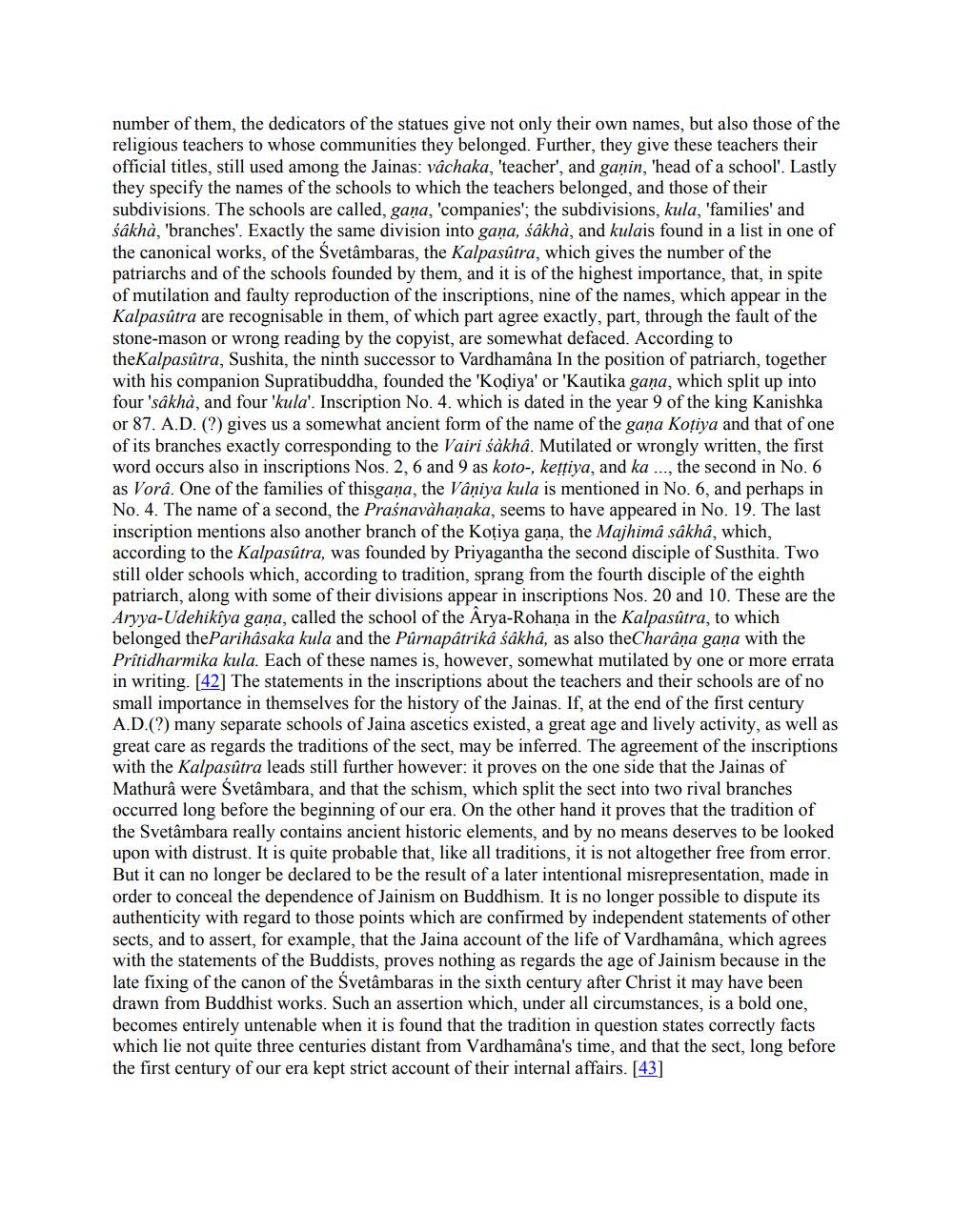________________
number of them, the dedicators of the statues give not only their own names, but also those of the religious teachers to whose communities they belonged. Further, they give these teachers their official titles, still used among the Jainas: vâchaka, 'teacher', and gain, 'head of a school'. Lastly they specify the names of the schools to which the teachers belonged, and those of their subdivisions. The schools are called, gana, 'companies'; the subdivisions, kula, 'families' and śákhà, 'branches'. Exactly the same division into gana, sâkhà, and kulais found in a list in one of the canonical works, of the Svetâmbaras, the Kalpasútra, which gives the number of the patriarchs and of the schools founded by them, and it is of the highest importance, that, in spite of mutilation and faulty reproduction of the inscriptions, nine of the names, which appear in the Kalpasútra are recognisable in them, of which part agree exactly, part, through the fault of the stone-mason or wrong reading by the copyist, are somewhat defaced. According to the Kalpasútra, Sushita, the ninth successor to Vardhamâna In the position of patriarch, together with his companion Supratibuddha, founded the 'Kodiya' or 'Kautika gana, which split up into four 'sákhà, and four 'kula'. Inscription No. 4. which is dated in the year 9 of the king Kanishka or 87. A.D. (?) gives us a somewhat ancient form of the name of the gana Kotiya and that of one of its branches exactly corresponding to the Vairi sàkhâ. Mutilated or wrongly written, the first word occurs also in inscriptions Nos. 2, 6 and 9 as koto-, kettiya, and ka ..., the second in No. 6 as Vora. One of the families of thisgana, the Vâniya kula is mentioned in No. 6, and perhaps in No. 4. The name of a second, the Praśnavàhaņaka, seems to have appeared in No. 19. The last inscription mentions also another branch of the Kotiya gana, the Majhimå sakha, which, according to the Kalpasútra, was founded by Priyagantha the second disciple of Susthita. Two still older schools which, according to tradition, sprang from the fourth disciple of the eighth patriarch, along with some of their divisions appear in inscriptions Nos. 20 and 10. These are the Aryya-Udehikiya gana, called the school of the Arya-Rohana in the Kalpasútra, to which belonged theParihâsaka kula and the Púrnapátrikå sâkhâ, as also the Charâņa gana with the Prîtidharmika kula. Each of these names is, however, somewhat mutilated by one or more errata in writing. [42] The statements in the inscriptions about the teachers and their schools are of no small importance in themselves for the history of the Jainas. If, at the end of the first century A.D.(?) many separate schools of Jaina ascetics existed, a great age and lively activity, as well as great care as regards the traditions of the sect, may be inferred. The agreement of the inscriptions with the Kalpasútra leads still further however: it proves on the one side that the Jainas of Mathurâ were Svetâmbara, and that the schism, which split the sect into two rival branches occurred long before the beginning of our era. On the other hand it proves that the tradition of the Svetâmbara really contains ancient historic elements, and by no means deserves to be looked upon with distrust. It is quite probable that, like all traditions, it is not altogether free from error. But it can no longer be declared to be the result of a later intentional misrepresentation, made in order to conceal the dependence of Jainism on Buddhism. It is no longer possible to dispute its authenticity with regard to those points which are confirmed by independent statements of other sects, and to assert, for example, that the Jaina account of the life of Vardhamâna, which agrees with the statements of the Buddists, proves nothing as regards the age of Jainism because in the late fixing of the canon of the Svetâmbaras in the sixth century after Christ it may have been drawn from Buddhist works. Such an assertion which, under all circumstances, is a bold one, becomes entirely untenable when it is found that the tradition in question states correctly facts which lie not quite three centuries distant from Vardhamâna's time, and that the sect, long before the first century of our era kept strict account of their internal affairs. [43]




